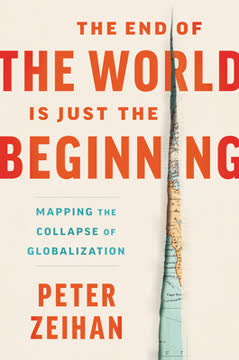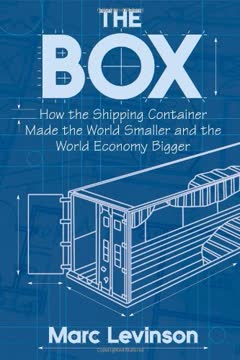Key Takeaways
1. Globalization's Evolution: From Goods to Ideas
In the next stage of economic development, it would be the flow of ideas and ser vices that would bind the world’s economies more tightly together.
Repeated Transformation. Globalization isn't a static phenomenon but a dynamic process, constantly reshaped by technological advancements, demographic shifts, entrepreneurial ambitions, and governmental policies. What globalization meant in 1890 is vastly different from its meaning in 1980 or 2020.
Distinct Stages. The book emphasizes viewing the period from the late 1980s to the early 2010s as a unique phase, the "Third Globalization," characterized by long-distance value chains enabled by advancements in transportation, communication, and information technology. This phase is distinct from what preceded it and what is likely to follow.
Future Focus. The future of globalization lies not in the movement of physical goods, but in the exchange of ideas and services. This shift marks a new era where intangible assets and intellectual capital become the primary drivers of economic interconnectedness.
2. The Perilous Path of Global Dreams: Early Globalization Failures
The notion of a long- distance industrial supply chain already beckoned, but the developments that made it practical were yet to come.
Early Attempts. Even in the 18th century, entrepreneurs like Peter Hasenclever envisioned global supply chains, but technological limitations and logistical challenges made such ventures impractical. His attempt to supply the Royal Navy with American-forged iron failed due to transportation issues and unreliable ocean shipping.
Historical Context. While trade across vast distances has occurred throughout history, pre-industrial economic relationships differed significantly from modern globalization. These early exchanges primarily involved luxury goods, slaves, or essential commodities, with international trade playing a limited role in the lives of average families.
Key Obstacles. Before the Industrial Revolution, trading was slow and expensive due to primitive transportation, the ubiquitous role of middlemen, taxes, and unreliable delivery schedules. These factors significantly hindered the development of extensive global supply chains.
3. Capitalism's Rise and the First Globalization
Under a system of perfectly free commerce, each country naturally devotes its capital and labour to such employments as are most beneficial to each.
Free Trade Ideology. The rise of capitalism in the 19th century brought with it new economic ideologies, most notably David Ricardo's theory of comparative advantage. This theory advocated for free trade, arguing that countries should specialize in producing goods they can produce most efficiently and trade for other needs.
Cotton Supply Chain. The cotton industry exemplified the First Globalization, with raw materials sourced from plantations in the Americas and processed in British mills before being exported worldwide. This global supply chain was characterized by intense competition and often exploitative labor practices.
Technological Prerequisites. Cheap transportation was essential for the cotton industry's global scale. Innovations like steamships and the telegraph revolutionized long-distance trade, making it feasible to coordinate production and distribution across continents.
4. World War I: The Abrupt End to Globalization's First Wave
the resumption of business on that morning would have made New York the only market in which a world panic could vent itself.
Financial Market Disruption. The outbreak of World War I in 1914 triggered a global financial crisis, leading to the closure of stock exchanges and the suspension of foreign exchange trading. This marked the beginning of the end for the First Globalization.
Trade Warfare. Disrupting international trade became a key strategic objective for both the Central Powers and the Entente allies. The British Royal Navy blockaded Germany, while Germany retaliated by threatening to sink merchant vessels bound for Great Britain.
Economic Nationalism. The war's aftermath saw a rise in economic nationalism, with countries increasing tariffs, restricting foreign investment, and prioritizing domestic control of shipping. This retreat from globalization was further exacerbated by the Great Depression.
5. Bretton Woods and the Second Globalization's Uneven Reach
Private owners of wealth have no right to the liberty to move funds around the world according to their private con ve nience.
Managed Exchange Rates. The Bretton Woods agreement of 1944 sought to create a more stable international monetary system with fixed exchange rates. However, it also imposed strict controls on capital flows to prevent financial instability.
North-South Divide. The Second Globalization primarily benefited wealthy countries in Europe, North America, and Japan, while poorer countries in the "South" remained largely commodity exporters. This unequal distribution of benefits led to critiques of globalization as a tool for exploitation.
Import Substitution. Economist Raúl Prebisch advocated for import substitution, arguing that developing countries should protect domestic industries with high tariffs and prioritize industrialization over free trade. This approach influenced economic policies in many parts of the world.
6. The Container Revolution: A Paradigm Shift in Trade
It is certain that the goods would occupy far less space if they were stowed individually instead of in containers.
High Shipping Costs. High transportation costs were a major impediment to international trade after World War II. Traditional methods of handling breakbulk freight were slow, labor-intensive, and prone to theft and damage.
Containerization. The introduction of container shipping in 1956 revolutionized the industry by streamlining cargo handling and reducing transportation costs. This innovation played a key role in enabling the Third Globalization.
Global Standards. The standardization of container sizes and lifting mechanisms was crucial for the widespread adoption of container shipping. This standardization allowed for seamless transfer of goods between ships, trucks, and trains, creating a truly intermodal transportation system.
7. Hot Money: The Unstable Foundation of Global Finance
Countries don’t go bankrupt.
End of Bretton Woods. The collapse of the Bretton Woods system in the early 1970s led to the deregulation of international finance and the rise of floating exchange rates. This created new opportunities for cross-border investment but also increased financial instability.
Petrodollar Recycling. The oil price shocks of the 1970s resulted in a massive influx of petrodollars into Western banks, which then lent these funds to developing countries. This led to a surge in LDC debt and an increased risk of financial crises.
LDC Debt Crisis. The LDC debt crisis of the 1980s exposed the risks of unregulated international lending. Many developing countries were unable to repay their debts, leading to economic hardship and social unrest.
8. Deregulation: Kindling for the Third Globalization
Markets became the unifying factor of the global economy.
Deregulation Movement. A global movement to deregulate business activity gained momentum in the late 20th century. Proponents argued that deregulation would foster competition, innovation, and lower prices.
Transportation Deregulation. Deregulation of transportation industries, particularly in the United States, led to lower freight rates and more reliable shipping services. This made it feasible for manufacturers and retailers to create intricate long-distance supply chains.
Financial Deregulation. Financial deregulation, while intended to promote efficiency, also created new risks. The lack of international oversight and the proliferation of complex financial instruments contributed to the global financial crisis of 2008.
9. The China Price: A Double-Edged Sword
You’re going to hear a giant sucking sound of jobs being pulled out of this country.
China's Rise. China's economic reforms and its accession to the WTO in 2001 transformed the global economy. The country became a manufacturing powerhouse, offering low labor costs and a vast market for foreign investment.
Job Displacement. The rise of China led to significant job displacement in developed countries, particularly in manufacturing. This fueled resentment and contributed to a backlash against globalization.
Uneven Benefits. While China's economic growth lifted millions out of poverty, it also exacerbated income inequality in many countries. The benefits of globalization were not evenly distributed, leading to social and po liti cal tensions.
10. Capturing Value: The Shift from Production to Intangibles
State borders define less and less the bound aries of corporate thinking or practice.
Value Chains. The Third Globalization saw the rise of global value chains, where production processes were fragmented across multiple countries. This created new opportunities for specialization and efficiency but also made it more difficult to track the origin and distribution of value.
Intangible Assets. As manufacturing became more automated, intangible assets such as intellectual property, design, and marketing became increasingly important sources of value. This shifted the focus from physical production to knowledge-based activities.
Trade Statistics. Traditional trade statistics, which focus on the movement of physical goods, became less relevant in a world of global value chains. Measuring value added became more important for understanding the true economic impact of international trade.
11. The Great Trade Collapse and the Retreat from Goods
By 2007, the world was more open than a century earlier and its inhabitants gained from trade substantially more than their ancestors did.
Financial Crisis. The global financial crisis of 2008 triggered a sharp decline in international trade, exposing the vulnerabilities of interconnected supply chains. This marked the beginning of a retreat from the hyper-globalization of the previous decades.
Sluggish Growth. After the initial recovery, trade growth remained sluggish, failing to return to its pre-crisis trend. This suggested that the forces driving globalization were weakening.
Regionalization. As global value chains became more complex and risky, companies began to regionalize their production networks, focusing on closer geographic proximity and greater control over their supply chains.
12. The Fourth Globalization: Ideas and Services Take Center Stage
In the next stage of economic development, it would be the flow of ideas and ser vices that would bind the world’s economies more tightly together.
Shifting Focus. The Fourth Globalization is characterized by a shift from the movement of goods to the exchange of ideas and services. Intangible assets and intellectual capital become the primary drivers of economic interconnectedness.
Service-Based Economies. As manufacturing declines in importance, service industries are becoming increasingly globalized. This creates new opportunities for workers in high-skilled professions but also exposes them to greater international competition.
New Challenges. The Fourth Globalization presents new challenges for governments, including the need to invest in education and training to prepare workers for the changing job market and to address the social and economic consequences of increased competition in the service sector.
Last updated:
FAQ
What’s [Outside the Box: How Globalization Changed from Moving Stuff to Spreading Ideas] by Marc Levinson about?
- Evolution of globalization: The book traces globalization’s transformation over two centuries, from moving physical goods to spreading ideas, services, and information.
- Distinct phases: Levinson identifies four waves of globalization, each shaped by technological, economic, and political changes.
- Focus on supply chains: It explores the rise and risks of global value chains, container shipping, and the shift from vertical integration to outsourcing.
- Analysis of challenges: The book examines vulnerabilities, political backlash, and the environmental impact of globalization.
Why should I read [Outside the Box] by Marc Levinson?
- Comprehensive historical context: The book provides a well-researched history of globalization, helping readers understand current economic and political debates.
- Insight into supply chains: It highlights the risks and complexities of global supply chains, which are crucial for businesses and policymakers.
- Understanding future trends: Levinson discusses the transition to a new era of globalization, focusing on ideas and services.
- Balanced perspective: The book explores both the benefits and downsides of globalization, including inequality, job losses, and political backlash.
What are the key takeaways of [Outside the Box] by Marc Levinson?
- Globalization is dynamic: It evolves through distinct phases, influenced by technology, government policies, and global events.
- Container shipping revolution: Standardized containers drastically lowered transportation costs, enabling global supply chains and reshaping manufacturing.
- Benefits and costs: Globalization lifted millions out of poverty and expanded consumer choices but also caused deindustrialization and increased inequality.
- New phase emerging: The future of globalization will focus more on the flow of ideas and services rather than just physical goods.
How does [Outside the Box] by Marc Levinson define and explain the phases of globalization?
- First Globalization (19th century): Driven by industrial capitalism, steamships, and the telegraph, it ended with World War I.
- Retreat (1914-1947): Wars and protectionism led to a sharp decline in trade and investment.
- Second Globalization (post-1947): Characterized by stable exchange rates, tariff reductions, and integration among rich countries.
- Third and Fourth Globalization: The late 20th century saw complex value chains and emerging economies; the current phase emphasizes ideas, services, and digital products.
What is the significance of container shipping in [Outside the Box] by Marc Levinson?
- Cornerstone of modern trade: Container shipping, introduced in 1956, drastically reduced costs and time, enabling global supply chains.
- Standardization and efficiency: International container standards allowed seamless transfer between ships, trucks, and trains.
- Impact on manufacturing: Containers enabled production stages to be located in different countries, fostering global factories.
- Industry challenges: The race to build larger ships led to overcapacity and financial risks in shipping.
How does [Outside the Box] by Marc Levinson describe the shift from goods to ideas and services in globalization?
- Decline of manufacturing’s share: Manufacturing’s role in global output and trade has decreased as services and digital products rise.
- Fourth Globalization: The current phase emphasizes the flow of knowledge, services, and digital goods over physical products.
- Corporate strategy changes: Firms now focus more on R&D, intellectual property, and service delivery, often outsourcing physical production.
- Technological and demographic shifts: Automation and aging populations further reduce demand for traditional manufacturing.
What are global value chains and how do they differ from traditional supply chains in [Outside the Box] by Marc Levinson?
- Traditional supply chains: Involved firms owning or buying inputs and producing goods mostly within their own factories or close suppliers.
- Global value chains: More complex networks where design, production, and services are outsourced across multiple countries.
- Trade statistics complexity: Components and services cross borders multiple times, making traditional trade balances misleading.
- Policy implications: Tariffs or barriers on inputs can disrupt entire production networks and competitiveness.
What risks and vulnerabilities of global supply chains does [Outside the Box] by Marc Levinson highlight?
- Operational disruptions: Labor strikes, natural disasters, and pandemics can halt production and shipping, causing economic damage.
- Hidden vulnerabilities: Companies often lack visibility beyond immediate suppliers, leading to costly recalls and shutdowns.
- Political and regulatory risks: Protectionism, trade barriers, and changing policies can disrupt global value chains.
- Industry overcapacity: Subsidies and competition led to oversized ships and overcapacity, increasing financial risks.
How does [Outside the Box] by Marc Levinson address the political and social backlash against globalization?
- Job losses and inequality: Globalization led to manufacturing job declines and wage stagnation in wealthy countries, fueling discontent.
- Rise of nationalism: Political movements opposing free trade and international cooperation have gained strength, exemplified by Brexit and populist parties.
- Challenges for policymakers: Traditional trade policies are less effective in addressing globalization’s negative effects.
- Social stability concerns: Balancing economic growth with social welfare has become more complex.
What role do government policies and subsidies play in globalization according to [Outside the Box] by Marc Levinson?
- Shaping competitiveness: Subsidies for shipbuilding, shipping, and manufacturing influence trade costs and patterns.
- Industrial policy: Countries like Japan, South Korea, and China used targeted subsidies and state guidance to develop competitive industries.
- Trade disputes: Subsidies and trade barriers led to conflicts and political backlash in importing countries.
- Impact on value chains: Government interventions can both support and complicate global supply chains.
How does [Outside the Box] by Marc Levinson explain China’s role in the Third Globalization?
- Latecomer to global trade: China was largely isolated until economic reforms began in 1978.
- Rapid industrialization: Special Economic Zones and foreign investment enabled China to become the world’s largest manufacturing nation.
- Government policies: Extensive subsidies and joint venture requirements helped develop export industries and integrate into global value chains.
- Global impact: China’s rise reshaped global manufacturing, supply chains, and trade patterns.
What practical lessons and advice does [Outside the Box] by Marc Levinson offer for managing global supply chains?
- Diversify suppliers and locations: Avoid sole sourcing and spread production across multiple sites and countries to reduce vulnerability.
- Increase inventories and flexibility: Higher stock levels and flexible manufacturing can buffer against disruptions but may raise costs.
- Monitor standards: Oversee the entire supply chain, including labor and environmental practices, to protect brand reputation and comply with regulations.
- Adapt to new realities: Companies must reconsider sourcing strategies and inventory management in light of rising risks and regionalization trends.
Review Summary
Outside the Box receives generally positive reviews, with readers praising its comprehensive history of globalization. Many find it informative and well-written, noting its detailed analysis of trade, shipping, and economic policies. Some reviewers appreciate the book's objective approach and its division of globalization into distinct phases. A few readers express disappointment with the limited coverage of future predictions and service-based globalization. Overall, the book is recommended for those interested in understanding the evolution of global trade and its impact on economies.
Similar Books










Download PDF
Download EPUB
.epub digital book format is ideal for reading ebooks on phones, tablets, and e-readers.





